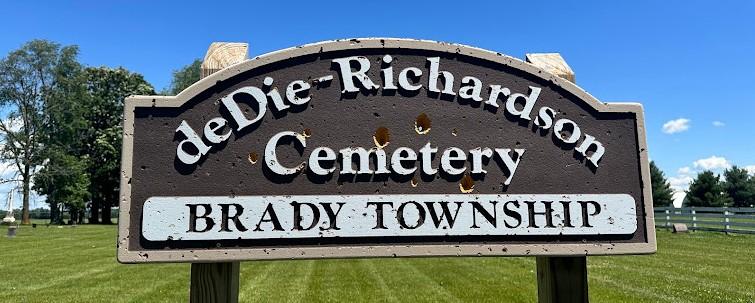

DEDIERICHARDSON CEMETERY RESEARCH AND RESTORATION

Introduction: Who am I?
DeDie-Richardson History
AGENDA
DeDie-Richardson Mysteries
Cemetery Restoration Goals
How You Can Help
Hello! My name is Dusti Morton, and it’s my pleasure to talk to you today about the work I’ve been doing out in the deDie-Richardson, aka Clement, cemetery.
The agenda for today’s talk on March 7, 2025, will be: An introduction about myself; information about deDieRichardson’s history; a brief discussion about some of the cemetery’s mysteries; my restoration goals; and how you can help.
Dusti Morton
* Kalamazoo Historic Preservation Committee
* Portage Historic District Committee
* Association of Gravestone Studies
Fossil Preparator, Academy of Natural Sciences of Philadelphia
* Cemetery Cleaning and Restoration Work:
Mountain Home, Mt Olivet, Litchfield, Sherwood, Union City, Oak Hill (IL), Evergreen (CO), Oakland (GA)


So, hi! I thought it would be a good idea to give you an idea of my credentials as I have taken on this work. I am a member of the Kalamazoo Historic Preservation Committee, the Portage Historic District Committee, and a member of the Association of Gravestone Studies. I’ve worked as a fossil preparator at the Academy of Natural Sciences in Philadelphia, which included working on unique specimens from Egypt. My cemetery preservation work has included working locally at Mountain Home and Mount Olivet, in the nearby towns of Litchfield, Sherwood, Lansing, Union City here in Michigan, and in cemeteries in Illinois, Colorado, and Georgia.
CEMETERY NAMES: DEDIE-RICHARDSON CLEMENT FRASER
SILVER STREET

WHY SO MANY
NAMES?
It’s not uncommon for historic cemeteries to have multiple names. In this case, the first name, Silver Street, was probably used by local residents, as I’ve found no written record indicating this was ever a formal type of name. Obituaries and death records use Clement and Fraser. DeDie-Richardson is a more recent official name, and was inspired by land donation.
CREATION OF THE CEMETERY

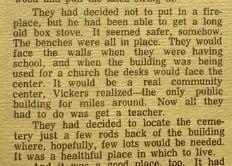

Strong Schoolhouse
Silver Street
First Cemetery by “Old El”?
Avenue East
Jenkinson Schoolhouse West
There is a mention in the Vicksburg history book “Water Over the Dam” that, when the first schoolhouse was built in Vicksburg, a small cemetery was placed nearby the building “just a few rods back, where, hopefully, few lots would be needed.” There is another historical reference in The History of Kalamazoo County that states, “A spot of land near the location of the old log school-house was, in an early day, used as a burial place merely for convenience; it was never regularly laid out as a cemetery, and its use was finally discontinued.” This was in the area where the Old El building is today.
We see this placement of cemeteries next to schoolhouses for Clement, Jenkinson, and Gourdneck. The Vicksburg Historical Society’s website indicates that the buildings came first. The Jenkinson schoolhouse was very close to the cemetery. Over at deDie-Richardson, the schoolhouse was a distance away. This was the Strong schoolhouse, which was donated and to the historic village, and a small collection of gravestones may be seen nearby; however, those stones are from the St John Evangelical German Lutheran Church cemetery that used to be located on YZ Avenue.
LOST PIONEER CEMETERIES?
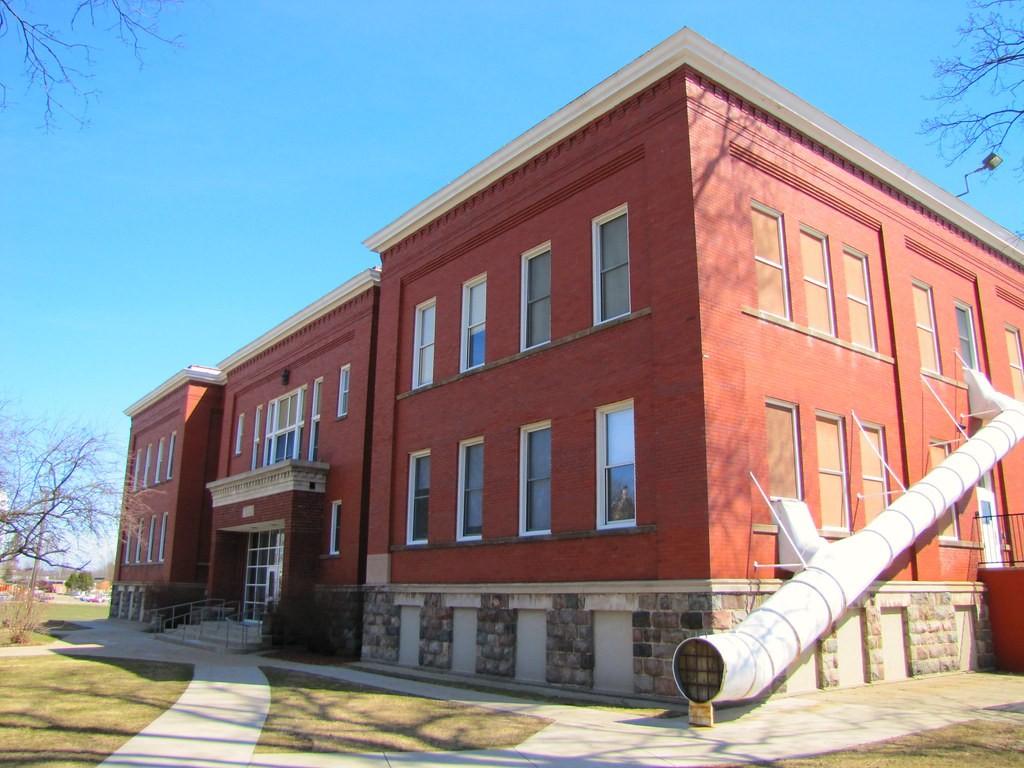


To continue a point from the previous slide, there is some anecdotal evidence that Vicksburg actually had two pioneer cemeteries that are lost to time. The Ladies’ Library Auxiliary posted a request for information about these in 1929 in an ad, stating, “Can any person give information regarding the two local abandoned cemeteries or the names of the persons who were buried in them? These cemeteries were abandoned about 1850 and were located as follows. – One was located at the rear of the log cabin schoolhouse which is now the site of our High School buildings some data stated. The other cemetery was located on the SW 1-4 of Sector 7, Bradley, just west of Wilson’s or late known as Butcher’s corner, on the north side of the road, and now owned by the Prudential Nursery Company. Persons now living definitely state that at least forty burials were made in this burial ground. Were your ancestors buried there, who can tell.” I haven’t found any evidence of responses to this advertisement, nor have I found any cemetery or burial records for either location.
EARLIEST CEMETERY BURIAL: 1821
CREATION OF CEMETERY ASSOCIATION: 1846
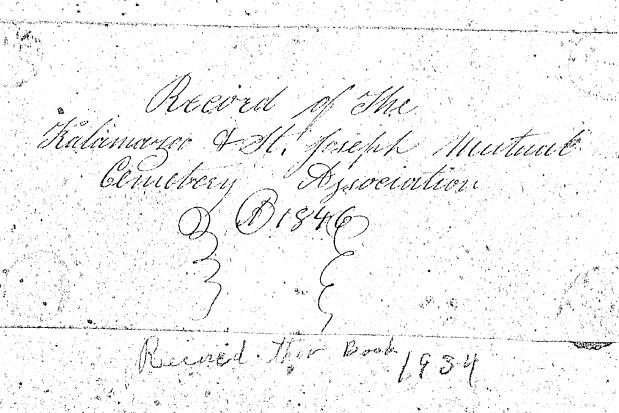


As Kalamazoo was being structured in the 1800s, and roadways were being decided upon, there are records of cemetery associations being created to manage public burial spaces. The Kalamazoo and St Joseph Mutual Cemetery Association was created in 1846 to formalize the organization of the cemetery on 24th Street. The committee met at the Strong schoolhouse annually in October to discuss property management and lot allocation. Interestingly, I found this document in records held by the Zhang Legacy Collections Center on the Western Michigan University campus. The records were a photocopy of pages taken from a larger volume I’ve yet to locate.
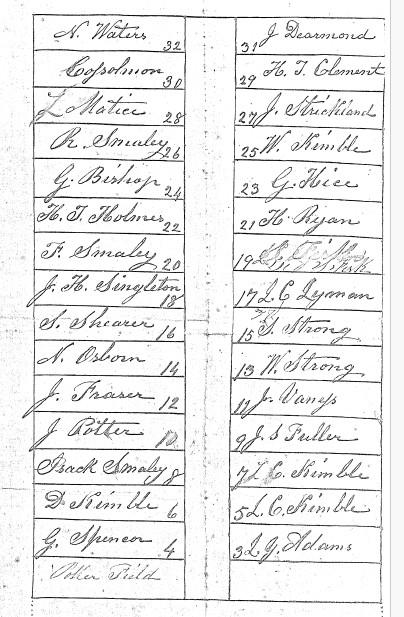

One of the most exciting records in this document are these two undated lot maps. Since the burial records for the historic portions of Clement cemetery appear to be missing, these pages have helped me identify some unmarked graves and understand better the boundaries of family plots. Worth noting: The original members of the Cemetery Association are well represented here, as are local land owners such as Copalman. I’m personally curious about the “Potter’s Field” indicator on the map to the left, as this lot was later purchased and used by the Coohon family. This also shows very clearly the original cemetery boundaries. Notes in the meeting minutes later indicate that property to the south was purchased from John Hamilton to extend the cemetery towards the Richardson farm.
IMPORTANT DATES
1846 – Cemetery founded by the Kalamazoo and St Joseph County Cemetery Association
1906 – ¼ acre of land purchased on south side of the cemetery
1912 – 1/3 acre of land purchased on south side of the cemetery (from John Hamilton?)
1974 – A transcription of all Kalamazoo cemeteries was completed and subsequently published by the Kalamazoo Valley Genealogical Society. Tombstone
Inscriptions in Kalamazoo County, Michigan: A Bicentennial Project.
June 2, 1981 – Metal fence and gate installed.
Prior to 1984 – Records of the historic section of the cemetery were lost in a fire.
May 7, 1991 – Robert and Regina Richardson donated .61 acres of land for cemetery expansion.
November 2, 1993 – Plot prices set at $150, for sale to residents of Vicksburg only.
Mid-1994 – A member of the Kalamazoo Valley Genealogical Society did a transcription survey of the cemetery. The records are currently MIA.
August 9, 1994 – The first burial in the new section of the cemetery occurred. Records start to be kept by the township at this point.
June 2, 1998 – Rules for the cemetery amended to allow non-residents to purchase plots for $400.
May 18, 1999 – Rules further amended to allow a mausoleum to be installed in the cemetery.
August – September 2002 – Eagle Scout project survey completed. The Bishop stones were found in the foot stone pit and placed in their proper position.
November 12, 2002 – A sign was installed at the cemetery.
March 2006 -> July 4, 2007 –Transcriptions were taken by varied groups and made available online.
July 7, 2009 – Recommendation made to repair some stones.
September 6, 2011 – Decision made by board to not repair gravestones.
February 14, 2017 – Car went through fence and knocked over some gravestones.
March 7, 2018 – Grave Opening Fees set at $375 for regular adult burials, $175 for cremains, and a scattering garden fee of $25.
Clement cemetery is fortunate in that it’s still an active cemetery. As such, I wanted to take some time to go over some important dates in the cemetery’s history. The next few slides will do just that.
Note that the first burial in deDie-Richardson occurred before 1846. The earliest markers date around 1820, and the graves probably had wooden markers. It’s hard to really know how many graves were here before the formalization of the cemetery.
I’d like to talk about some of the discoveries I’ve made in my first year of working on deDie-Richardson, which has been focused on the first row of the cemetery. I will then highlight some of the mysteries I’m still hoping to solve, either through research or through information from community members.

DEDIERICHARDSON MYSTERIES


These three photos show objects that were identified as broken gravestones in all of the surveys listed earlier. They are located near the front of the cemetery and, without a burial map, I couldn’t idenfiy whose graves they have been marking.
Last summer, I started uncovering these stones, hoping to find enough pieces for me to be able to reassemble them.
THE KIMBLE PLOT
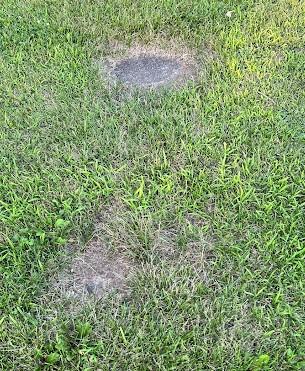


What I discovered under the sod was that these weren’t gravestones. They were unmarked ledger stones. It took me a while to figure out if they were place markers over unused graves or covering occupied plots. However, through records found on Ancestry.com and the Vicksburg Public Library, I confirmed that David, Jerusha and Elva Kimble were all buried in this cemetery, although there are no headstones to indicate where they rest. And after I found the cemetery association notes, I could verify that this was the David Kimble plot. This spring, I will be installing some plaques to identify these graves as potentially being those of the Kimble family, and I’ve put some edging around the ledger stones to try to keep them from being covered again by dirt and sod.
I want to take a moment to say that while I’m working in deDie-Richardson, I’m only working on the historic portion of the cemetery, and only on plots that do not appear to have anyone actively caring for them. I am doing so with the permission of Brady township. In the case of the Kimble family, they are very much taking care of their identified family plots. I contacted a family member about the work I did, and I do not have plans to do more than I’ve done, now that we can be fairly certain who is resting here.



The surveys and transcription projects I referenced earlier indicated that Lizzie DeWolf was buried in deDie-Richardson and that her stone should be next to Myron Heffron, near the front of the cemetery. Lizzie’s mother, Mary, was Myron’s sister. The stone fell down over the past 20 years or so, and was very lightly covered with dirt.
LIZZIE DEWOLF

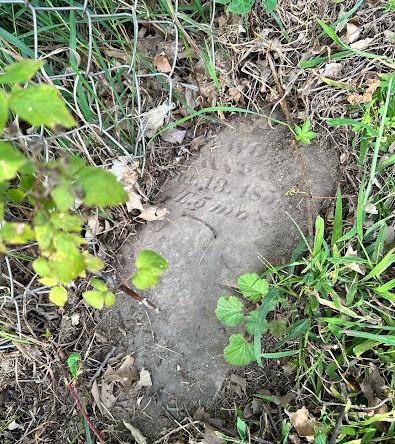
Discovering and resetting Lizzie’s stone was one of my first accomplishments last summer, and one of my first research subjects. She also has a headstone in the Schoolcraft cemetery, which I believe to be a cenotaph, as I believe her body was laid to rest here in deDie-Richardson. She was the first of her family to pass away. The stone to the right is the one that’s in Schoolcraft.
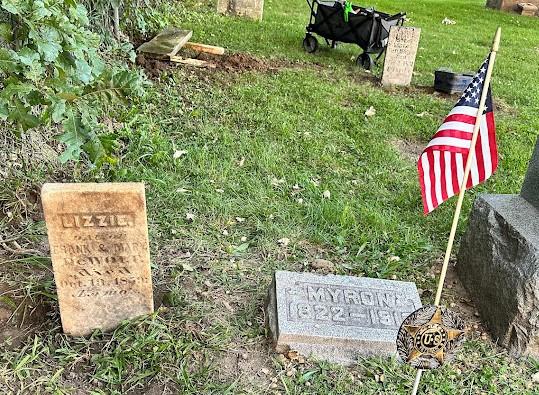
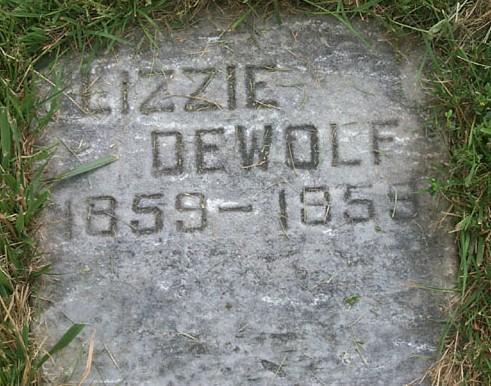
One of my goals for this project is to map out the cemetery, and I’m relying a lot on those past surveys and transcriptions. They all indicated there was a stone for Tille Coohon in the first row of the cemetery, but by 2024, her stone was missing. I looked at the broken stone for Mariah Spencer directly behind Tillie’s plot and realized that someone had taken Tillie’s stone and leaned it against Mariah’s, possibly because the type of marble was very similar. I moved Tillie’s stone forward and then found the base of her stone exactly where I would have expected it to be. What you see in that lower photograph is that Tillie’s gravestone was originally held in place on its base by iron pegs in a technique known as pinning. It seems like a great idea. Unfortunately, the pins were often made out of iron, and when water touches the iron, damage occurs. In this case, the pins in effect blew apart the bottom of the gravestone. Also, the base the stone was pinned to had sunken over time. You may also see scratches on Tillie’s stone. This is pretty common and is caused by lawnmowers or weedwhackers. If we can get the stones back up and raised off the ground, they are less in danger of being damaged in this way.
TILLIE COOHON

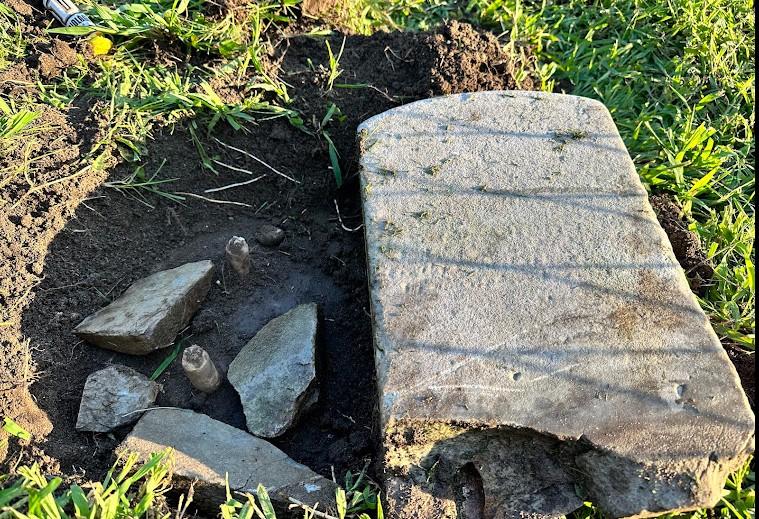
Working on Tillie’s stone taught me a few things, including marble is heavy! I needed to get some better tools to use to lift sunken bases out of the ground. Not shown is that the holes you see were filled with a putty to keep water from getting into the repair and doing further damage before I put the stone back on its base and mortared it in place. All of the material being used for headstone repairs has been vetted by the monument repair industry and are safe to be used. The motto is to do no harm. The cleaner I use is called d/2 and it cleans marble and granite while also slowly killing off the lichens that like to get deep into the stone. We use specialty epoxies and historic mortars, and repair work is done in a way that, if something happens to that stone in the future, it should fail along the repair line rather than cause a new break in the marble.


Ok, so. Let’s talk about some of what happened over the years. Cemetery maintenance across the US didn’t traditionally involve a lot of lawn mowing until more modern times, and when people started regularly mowing, things like footstones, plantings, and fencing started to become a problem because they got in the way of lawnmowers. Fences and borders were removed from many family plots. In Denver, we know that heirloom roses were removed from some cemeteries to make the grounds easier to mow. And very often, footstones were pulled up and buried in unused portions of historic cemeteries. I don’t know when this pit was created in deDie-Richardson. My understanding is that Jenkinson cemetery had a footstone pit as well, and I believe those stones have been used to mark previously unmarked graves.
THE PIT

In 2002, the Eagle Scout that worked on a survey of this cemetery was able to locate the gravestones of Catharine and Ruhama Bishop in the pit and successfully replace them on their gravesites. I have found two partial stones that I’ve been able to identify, but I haven’t yet figured out where their graves might be. I’ve pulled out every footstone that has an initial on it and matched it up to an existing grave. These will be reset a foot behind their corresponding headstones as I work my way through the cemetery. Pictured are the Bishop stones, which I’ve repaired, and which have had their footstones reset about a foot behind their respective headstones. This is how most preservationists are resetting footstones in cemeteries across the US.


I mentioned that I have mysteries I’m hoping to solve. Who is J C Cole? He’s buried in the front row of the cemetery. He has a beautiful stone. I have found burial records indicating that Nancy and Peter Cole are also buried here, but I don’t know where. Who is Richard Caselman? He was a Civil War soldier. His last name is listed as Caselman, Crossman and Castleman in the military records. But I haven’t been able to verify who his family was, and I have no idea why he’s buried in the back of the cemetery by himself. (Side note: One of the first things I did at deDie was to get military grave markers and flags for our handful of veterans, and Richard’s stone got a thorough cleaning. He’s going to be cleaned again this spring, and hopefully by 2026 that awful lichen will be removed.) Where are the burial records? They were referenced in 2002, and again in 2007, and used to locate unmarked graves. But today, no one seems to be able to locate them. They would be invaluable to my research and to creating a thorough documentation of this little treasure of Vicksburg history.



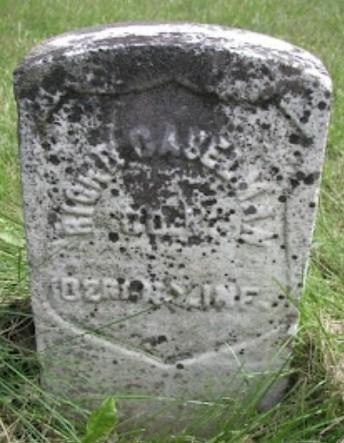
I have some pretty ambitious goals for deDie-Richardson. And it’s gonna take a few years. One of my primary goals is to create comprehensive documentation about the cemetery that will include its history, its graves’ locations, and the work that’s been done previously as well as currently to preserve these headstones. Families have been working on their ancestors’ stones for some time, and I’m striving to record those repairs as best I can. I’m documenting what’s been used in these preservation efforts so that the next generations will have that information. We’re lucky in that I don’t see evidence of anyone using bleach to clean headstones here. We’re a little unlucky in that some of these stones have been reset in concrete, which is problematic, because it’s stronger than the marble and can lead to future damage. and because the cemetery is surrounded by farmland, some of these stones have gotten pretty dirty from what I think is fertilizer. I’m also trying to decipher inscriptions that haven’t been recorded in the past, and some of those are getting easier to read as the stones are being cleaned. I very much want to try to locate unmarked graves, perhaps using some of those discarded footstones as new markers.
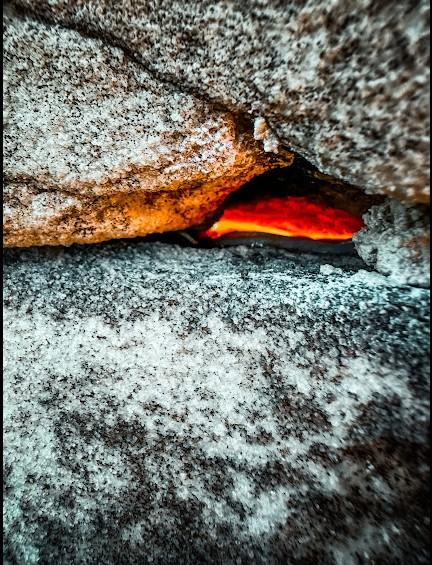
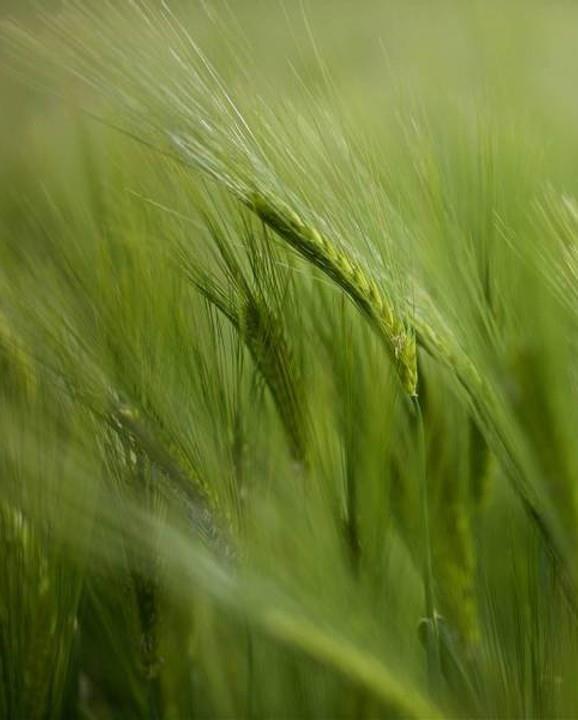
CEMETERY RESTORATION GOALS
The reason I was drawn to deDie-Richardson is that this is where the Fraser family was laid to rest. I’m not from here, but I love the history of Fraser’s Grove, and it hurt my heart a little that their family monument didn’t appear to have been cleaned for some time. This photo shows the family monument after I cleaned the marble, removed a mostly dead shrub and repaired the planter. I would dearly love to see a historical marker placed in this cemetery that tells the story of Jeannette Fraser. Additionally, I plan to design some gravestone markers, like the ones used by fraternal societies, to mark the graves of our local spiritualists and our pioneer families. My goal is to have these 3D printed and have the files be publicly available for free.




And honestly, y’all…deDie-Richardson needs help. There are monuments that are in serious need of resetting. The Smalley family monument is on the way to being dangerous. The Potter family monument is too large for one person to repair. The DeArmond family monument is in strong need of being releveled and reset. There are some gorgeously carved stones that are much too heavy to be lifted, leveled, and reset. This work can all be done, and it’s all worthy of being done, but it’s all going to need equipment I don’t possess. So a major future goal is to find a way to raise money and get that equipment and the skilled experts to come on out and help. I have an expert ready to work. I just don’t have the rest of it...yet.


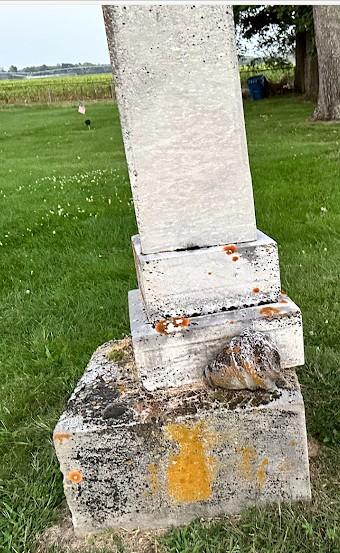
The easiest way to help is to share information! Tell people about the work being done out at the cemetery. Tell me what you know. Help me learn the stories of these ancestors. Do you know of a family taking care of plots out here? Help me get in touch with them. Would you like to come out and see the work being done? Do you want to help? Do any of these projects sound like something you want to help support? Let me know!
Thank you for your time!
How can you help?
